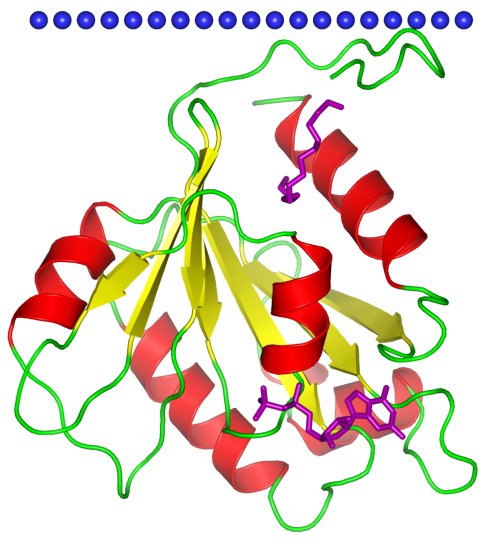Mempro™ P-Loop Containing Nucleoside Triphosphate Hydrolase Production Using Virus-Like Particles
Creative Biostructure can provide advanced custom Mempro™ P-loop containing nucleoside triphosphate (NTP) hydrolase production services based on virus-like particles system.
P-loop containing NTP hydrolase superfamily proteins have a structural domain called P-loop containing NTP hydrolase fold, which is the most common domain of the several distinct nucleotide-binding protein folds. Members of P-loop containing NTP hydrolase superfamily contain common sequence patterns but are two distinct motifs, the Walker A motif (the P-loop proper) and Walker B motif that binds, respectively, the beta and gamma phosphate moieties of the bound NTP, and a Mg2+ cation. It is reported that P-loop NTP hydrolase shows substantial substrate preference for either ATP or GTP.
 Figure 1. ADP-ribosylation factor 1 (ARF1). (OPM database)
Figure 1. ADP-ribosylation factor 1 (ARF1). (OPM database)
Virus-like particles (VLPs) can mimic the native virus, but are non-infectious owing to they do not have any viral genetic materials. VLPs are self-assembly multiprotein structures, which are widely used in the field of vaccinology. VLPs derived from the Hepatitis B virus and composed of the small HBV derived surface antigen (HBsAg). Recently, virus-like particles carrying conformationally-complex membrane proteins (termed lipoparticles) have been applied for integral membrane protein production. Lipoparticles can incorporate a wide range of structurally intact membrane proteins, including G protein-coupled receptors (GPCRs), ion channels.
Creative Biostructure provides high-yield P-loop containing NTP hydrolases in the stable, highly purified and native-conformation state. Lipoparticles can be produced from bacterial cells, yeast cells, insect cells, plant cells and mammalian cells for P-loop containing NTP hydrolase production. Well-characterized Escherichia coli (E. coli) strains and insect cells are the most widely used systems for VLPs production. Mammalian cells are also widely used for VLPs production with the target to construct vaccine candidates and gene therapy agents. For instance, we can obtain lipoparticles from mammalian cells by co-expressing the retroviral structural core polyprotein, Gag, along with a desired membrane protein. Gag core proteins self-assemble at the plasma membrane, where they bud off and capture target membrane proteins. Since the P-loop containing NTP hydrolases within lipoparticles are derived directly from the cell surface without mechanical disruption or detergents, the native structure and orientation of P-loop containing NTP hydrolases are retained.
Creative Biostructure provides other various Mempro™ membrane protein production services. Please feel free to contact us for a detailed quote.
References:
A. Roldão, et al. (2010). Virus-like particles in vaccine development. Expert Rev. Vaccines, 9(10): 1149-1176.
J. Sang, et al. (2006). Duplication and combination of P-loop containing nucleotide triphosphate hydrolases superfamily. Wuhan University J. Nat. Sci., 11(3): 577-580.
S. Willis, et al. (2008). Virus-like particles as quantitative probes of membrane protein interactions. Biochemistry, 47(27): 6988-6890.
Y. Kawamura, et al. (2003). Systematic analyses of P-loop containing nucleotide triphosphate hydrolase superfamily based on sequence, structure and function. Genome Informatics, 14: 581-582.